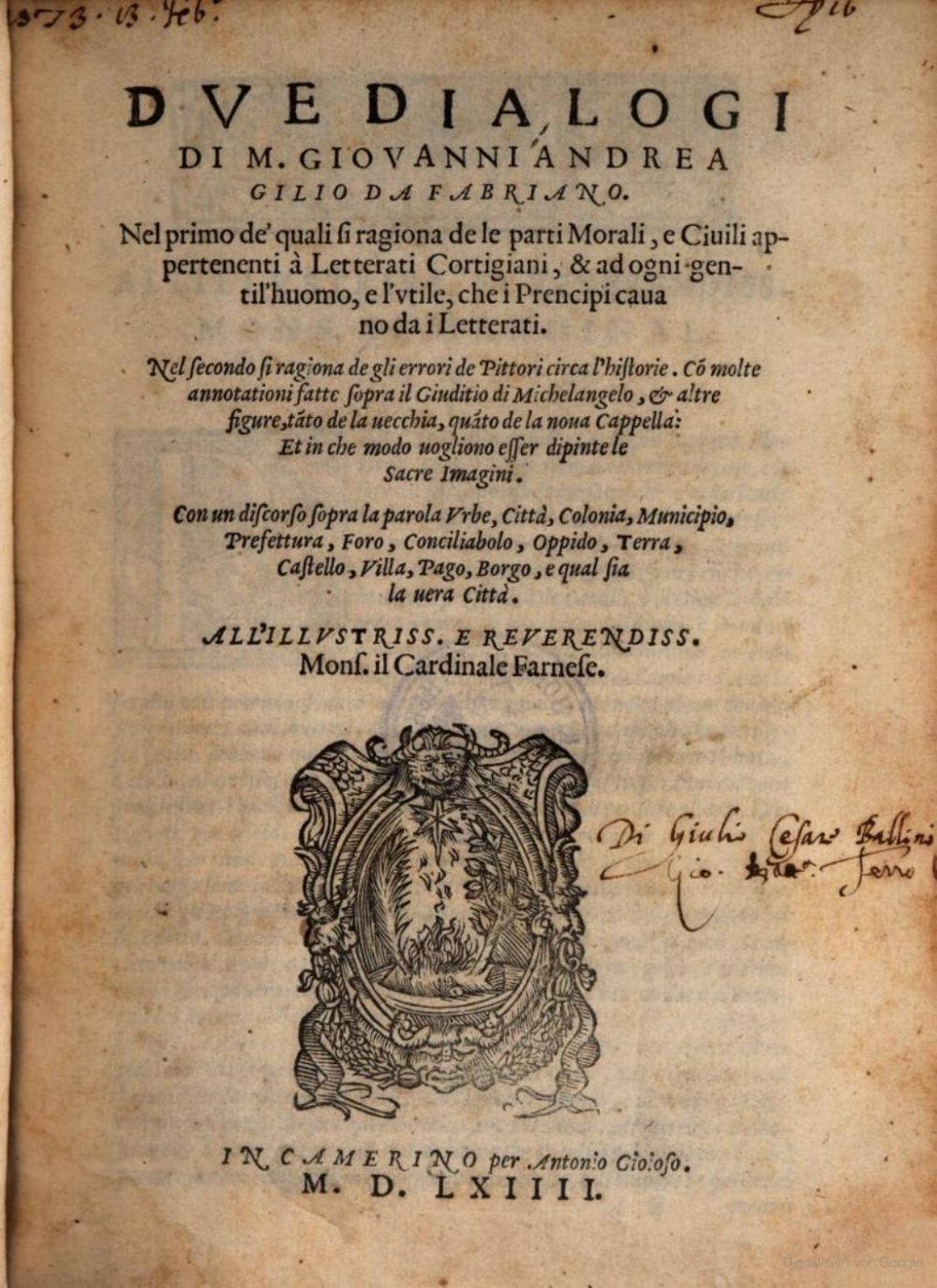
© ÖNB ABO Projekt/in Kooperation mit Google, Sig. 74.E.84 ALT PRUNK
The topic of the dialogue section is the representation of God. Although the participants agree that such a depiction is against divine law, M. Pulidoro and M. Troilo argue in favour of it. They reason that the original prohibition was imposed on the people of Israel, who were prone to idolatry. Since this danger does not exist in Christianity, the Holy Roman Church does not need to prohibit such a representation. Furthermore, it lets the illiterate understand that God created everything.
“M. Troilo continued: ‘There is another thing that seems to me to have introduced abuse, because it is against divine law. That is, that while God comanded Moses that children of Isreal should not portray his image in any form, given that he is spirit (and as spirit he cannot be known, let alone painted), painters do represent him in various ways; and they were not to portray the image of anything there might be on the earth, in the heavens, or in the sea. And now painters represent God as an old man, with a white beard. Do you believe this is commandment also extends to us?’
‘As for painting God’s image’, said M. Pulidoro, ‘ there is no way of showing that he is spirit; because what form or resemblance would we give to something when we do not know what or how it is? As for other images of the heavens, the sea, and the earth, the prohibition on portraying them what’s imposed on that people (of Israel) because they were too obstinately inclined to evil and idolatry; for being surrounded by pagans and being moved by their example, the easiest thing would be that they too, through weakness of the flesh, would become idolaters. But given that we do not have the inclination and are not subject two dead danger nor the zealotry, the Holy Church does not prohibit us from such things, because we will not adore images as God, as they would have done’.
M. Ruggiero replied: ‘Why then is God the Father painted as an old man, if we do not know what form he has?’
M. Pulidoro replied: ‘Because he cannot be painted as a spirit, given that we do not know what form, color, or being he might have (and it was this that made many commit idolatry), he is therefore painted as an old man, and the church tolerates this in order to show that many mysteries attributed by the pagans to the gods were carried out by our own true, great God: like the creation of the world, the explosions of the rebel angels, the wise government of the world, and many other similar things. He is painted as an old man in order to demonstrate the supreme knowledge that he possesses, because he existed before all things and before the world; also because the prophet Daniel saw him in that form, served by thousands of angels, and so too Saint John the Evangelists saw him in his revelations.
‘I think’, added M. Troilo, ‘That the church tolerated and tolerates this not only for our instruction but also to allow the ignorant, who cannot read, to see those figures and to understand that our great God created everything, as M. Pulidoro said earlier, and not Jupiter, as the poets asserted’.”
“Sequitò M. Troilo: ‘Un’altra cosa mi pare che abbia introdotta l’abuso, che è contra il divino precetto. Quest’è, ch’avendo egli comandato a Mosè che non dovessero i figliuoli d’Israelle ritrare in alcun modo la sua imagine, essendo egli spirito (e che sia spirito non si può sapere, non che dipingere), i pittori lo dipingono in più modi; e meno dovessero ritrare imagine di cosa che fusse in terra, in cielo o in mare. Et ora i pittori dipingono Iddio come un vecchione, con la barba bianca. Credete voi che quel precetto si stenda anco a noi?’.
‘Quanto al dipingere l’imagine di Dio’, disse M. Pulidoro,’che è spirito non si può in verun modo mostrare; perché, qual forma o somiglianza daremo noi a quello che non sappiamo che o come sia? Quanto a l’altre imagini del cielo, del mare e de la terra, fu negato a quel popolo il poterle ritrare, come ad ostinato nel male e nel troppo a l’idolatria inchinato, avendo intorno intorno i Gentili, dal cui esempio mossi facilissima cosa era che ancor essi, come carnalissimi, idolatrassero. Ma la Santa Chiesa a noi che non siamo in quella inclinazione, in quel pericolo, né in quel zelo, non ci proibisce simil cose, perché non l’adoreremmo per Iddio, come essi fatto arebbono’.
Disse M. Ruggiero: ‘Perché dunque Iddio padre si dipinge come un vecchione, se non si sa che forma abbia?’.
Rispose M. Pulidoro: ‘Perché come spirito non si può dipingere, non sapendo che forma, che
colore, che essere s’abbia (e questo è stato, che ha fatto a molti commettere l’idolatria), si dipinge come un vecchio, ché così tollera la Chiesa per mostrar molti misteri, che da’ Gentili furono attribuiti agli dii, essere stati operati dal nostro vero e grande Iddio: come il creare il mondo, il cacciar gli angeli apostati, il governar con tanta prudenza il mondo, e simil altre cose. Si dipinge vecchio, per dimostrare la somma sapienza che è in lui, per esser stato prima che tutte le cose e prima che ‘l mondo. E perché Daniel Profeta in quella forma il vide, a cui servivano migliaia d’angeli; così anco il vide Giovanni Evangelista ne le sue revellazioni’.
‘Mi penso’, soggiunse M. Troilo, ‘che la Chiesa non solo per nostra istruzzione abbia ciò tollerato e tolleri, ma acciò che gli ignoranti, che leggere non sanno, vedendo quelle figure sappino che il nostro grande Iddio ha fatto il tutto, come dianzi disse M. Pulidoro, e non Giove, come i poeti hanno tenuto. Ma in una cosa mi pare che errino i pittori’.”
Gilio 2018, 125-126, n.118-121



